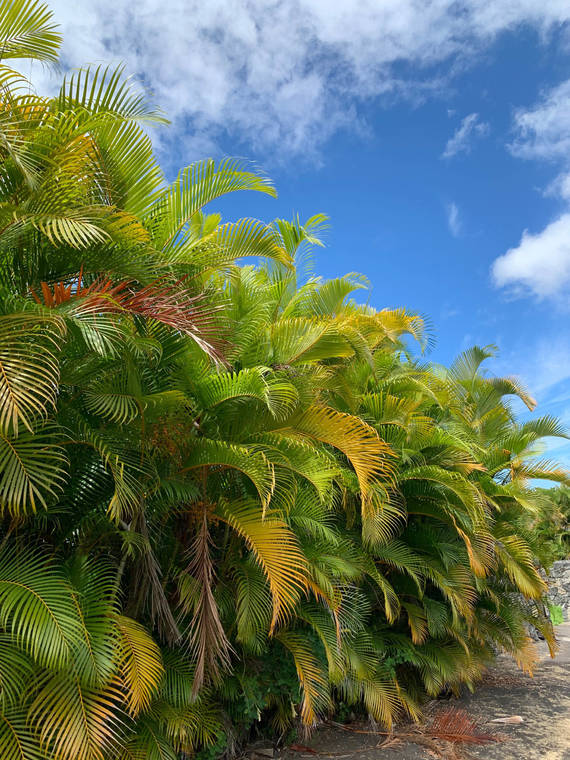Tropical Gardening: Your lawn might be hungry and thirsty now

Courtesy of VOLTAIRE MOISE Your landscape will tell you when it is time to supply nutrients. Here, Areca palms (Dypsis lutescens) are showing signs of hunger. A balanced fertilizer with nitrogen, phosphorus and Potassium will help, but in this case minor elements, especially magnesium, will give the palms a healthy dark green appearance.
Global warming has made forecasting weather a big gamble.
Global warming has made forecasting weather a big gamble.
Generally speaking, Hawaii’s rainy season is usually November through April. The exception is Kona, which has a summer rainy season with a dry winter. Other variables include elevation and the effect of moisture-bearing trade winds.
ADVERTISING
Thus, mauka areas of the windward side might receive 200 or more inches of rain while coastal South Kohala might receive very little rain throughout the year. On the leeward side, coastal Kona might receive 30 inches of rain in the summer, but at 2,000-4,000 feet in elevation, summer rainfall can be 60-100 inches.
Whether you have a home with a large yard or an apartment with a small lanai, plants create a more luxurious mood. The key to success is to put the right plants in the right place.
Besides trees, shrubs and bedding plants, one of the main elements of many landscapes is ground covers, including grass. It might be Bermuda, buffalo, centipede, zoysia, seashore paspalum or a mix. Whatever type of lawn it is, green and healthy is the key. It is important to remember that lawns generally require more maintenance, fertilizer and water than more deeply rooted ground covers, shrubs and trees. Thus, many communities are minimizing turf except in parks and recreational areas.
From a practical standpoint in the tropics, a lawn serves a number of ends.
First, it reduces heat and glare as the sun beats down on the earth. Green is a soothing color. No doubt that is why there is so much of it in nature. Second, it controls mud and erosion. It definitely beats concrete and asphalt or gravel.
The chief value of a lawn over other kinds of ground covers is that it offers a pleasing place to walk and play, as well as being artistic. In a dry area, a grass such as Bermuda makes a successful path, or can be used for auto parking.
A well-maintained grass cover also offers one of the easiest ways to control weeds. Just mow frequently and fertilize occasionally, making sure the grass cover has sufficient water to keep its green color.
Of course, if you want a perfect lawn that is a different proposition. Your idea might be just a green expanse to set off the surrounding landscape. Then it really does not matter of what the expanse consists. It might be a combination of grasses kept in check by frequent mowing.
There is, no doubt, a legitimate reason for cultivating a green expanse around a dwelling even in the tropics. But let’s not make such a burden out of it. When a weed pops up here and there, let it be. The secret is not in exterminating the weeds, but in keeping the area mowed so the weeds cannot dominate and go to seed, keeping them from spreading too much.
Whatever type of lawn you have, chances are it will require watering, except in the extremely rainy locations. Deep watering is preferred. Frequent shallow watering will encourage shallow rooting. It is best to water in the early morning. There is less waste of water through evaporation at that time.
Wherever you live, the first plants to show water stress are those with shallow roots. These are good indicators as to when you need to irrigate. They are also likely to tell you when to fertilize if you are sensitive to your plants’ needs. You should apply plant nutrients when the soil is moist during rainy periods or when you can supplement water with irrigation.
Green, growing things need fertilizer. This is especially true with lawns. A fast growing grass such as Bermuda might need fertilizer every month. On the other hand, zoysia can be fertilized 3-4 times each year or less. A slow-release fertilizer high in nitrogen is usually the best.
The important thing is to think green. We humans have created too much desert in the past.
The old saying “rain follows the forest, desert follows man” does not need to apply to wise Hawaii gardeners.


